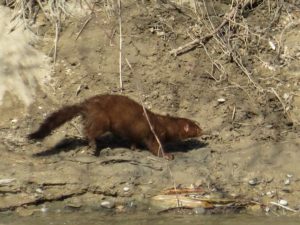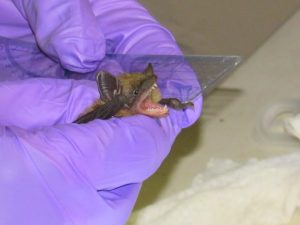
American Mink (Neogale vison)
The American Mink is a medium-sized amphibious weasel species native to wetlands throughout temperate and boreal Canada. In fact, mink can be found in every Canadian province and territory. Mink are strong swimmers and excellent hunters, feeding on fish, amphibians, birds, small mammals, and crustaceans in their wetland homes. Mink breed in late winter to early spring and give birth to four to six kittens in late spring. Mink make dens close to the water and are able to swim from a very young age.
American Mink are highly valued for their dense and lustrous fur, the most valuable of any fur-bearing species in Canada. The value of their fur made mink farming a lucrative business throughout the world, including Europe. However, when these mink escaped or were intentionally freed from fur farms, they began causing ecological damage throughout the continent. American Mink are now an invasive species throughout much of Europe, putting native mammal and bird species at risk from their aggressive predation. In the United Kingdom, American mink have caused major population decline of the once-prevalent Water Vole, an important species in wetland ecosystems in the UK. American Mink are a clear example of a species with an important ecological role in one part of the world causing significant ecological harm when imported to another area, and are a lesson in the importance of preventing the introduction of non-native species to new areas.
References:
American mink (neogale vison). iNaturalist. (n.d.). https://www.inaturalist.org/taxa/1264432-Neogale-vison
McTaggart-Cowan, I. (2006, February 7). Mink. The Canadian Encyclopedia. https://www.thecanadianencyclopedia.ca/en/article/mink
The Wildlife Trusts. (n.d.). American mink. The Wildlife Trusts. https://www.wildlifetrusts.org/wildlife-explorer/mammals/american-mink

Big Brown Bat (Eptesicus fuscus)
The Big Brown Bat is Ontario’s second largest bat species. Often seen flying overhead on summer evenings throughout Ontario, this species lives anywhere with enough food and shelter and can even be seen in urban areas. This is the most common bat species to be found roosting in homes and buildings, as it is tolerant of a wider range of roosting conditions than most other bat species. In fact, big brown bats will roost in anything from abandoned mines and old churches to caves and tree cavities.
Big Brown Bats do not migrate, so the spend the winters hibernating in hibernacula. While hibernating, their body temperature can drop as low as 3 degrees Celsius, which allows them to reduce energy use when their main food source (flying insects) is scarce. However, hibernating also puts these bats at risk of white-nose syndrome.
White-nose syndrome is a fungal disease that grows on the exposed skin of their faces and wings. This infection causes them to wake up more often during the winter, expending crucial energy reserves and often causing death. Fortunately, Big Brown Bats are less susceptible to this disease as other bat species as they roost in warmer places. Aside from white-nose syndrome, Big Brown Bats also face hazards from humans when they roost in buildings, as well as pesticides that travel through the food chain and build up in their bodies. Additionally, habitat loss and collision with wind turbines pose threats to all North American bat species. Many North American bat species are experiencing significant population decline, and the future of bats on the continent is uncertain. However, many organizations across Canada, the United States, and Mexico are working to protect bats and ensure a secure future for these amazing species.
References:
2023 state of the Bats Report. Bat Conservation. (2023, May 17). https://digital.batcon.org/state-of-the-bats-report/2023-report/
Big brown bat. NCC. (n.d.). https://www.natureconservancy.ca/en/what-we-do/resource-centre/featured-species/mammals/big-brown-bat.html
Bat species of Central Canada. Neighbourhood Bat Watch. (n.d.). https://batwatch.ca/bat-species-central-canada
